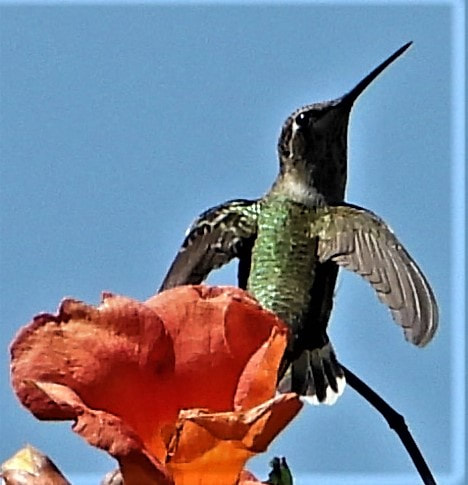
It's tough! Even when the light seems perfect, and my 125X camera is set on sports mode. The little buggers are fast! Especially when they're in defense mode, protecting a food source from other hummers.
Around here, at least now, in late August and early September, I have mostly (if not entirely) what I think are Rufus Hummingbirds. The Audubon map indicates that here in Arizona they are common during migration. I'm guessing this is their fall travel time as it's been very fall-like for the last few days.
Native American Headdress
I love the fantastic orange-and-black-accented tailfeathers on these guys—like they're wearing Native American headdresses on their butts. If I'm not mistaken, they spread those tailfeathers widest while screeching threats at each other. But maybe it's just part of their quick stops into stationary hovers. After all, they're pretty much always screeching threats at each other.
Beauty of Birds notes that Rufus and Ruby-Throated are the most common hummingbirds across the U.S., and describes some fascinating things they do, some of which I've been lucky enough to witness.
For example, back in Lake Hughes hummers indeed drank sap from holes in a tree trunk. (Apparently, some other sapsucker makes those holes, and the hummers later take advantage.) Everyone thought I was just making stuff up! But there it is. On the internet. So, it must be true!
Are Hummingbird Feeders OK?
I'm always leery of feeding wild animals, worried I might be giving them the wrong thing, making them less healthy, or keeping them from doing what they should. (Like maybe migrating south for the winter.)
So, it's wonderful to know that Audubon approves. Of course, flowers are better if you can keep the garden blooming. In my yard, when they can, hummers enjoy Orange Trumpet Flowers and Mimosa fluffs (photos above), Red Yucca and Salvia, among other things. But with our current drought, they can often use a little extra boost from a feeder.
I try to judge how much they'll drink so that the feeder runs out within three or four days without wastage. And I clean them well before refilling; sugar water can turn to icky slime before you know it, and that can't be good for a bird.
Hummingbird Sugar Water
(Approved by Audubon)
Materials:
• 1/4 cup refined white sugar
[Audubon Editor's note: Please do use refined white sugar. Honey can promote dangerous fungal growth. Organic, natural, and raw sugars contain levels of iron that could be harmful. Plain white table sugar is sucrose, which, when mixed with water, very closely mimics the chemical composition of natural nectar.]
• 1 cup boiling water
• Bowl
• Spoon
Note: There's no need for red dye here. Red coloring is not necessary and the chemicals could prove to be harmful to the birds.
Steps:
1. Mix sugar and boiling water until sugar is dissolved.
2. Cool and fill feeder.
3. Hang up your feeder outside and wait for the hummingbirds to come.
Enjoy!!!!
And if you get a chance, let me know in the comments what you see at your feeder or flowers.







